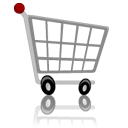|
||||||||||||||||||||||||||||||||||||||||||||||||||
|
||||||||||||||||||||||||||||||||||||||||||||||||||
 |
ADDITION You add when you want to find how many of something there are all together. Addends are the numbers you add. For example, here we have seven plus three equals ten. Our addends are seven and three. The sum is the answer when you add. The sum to this problem, seven plus three equals ten, is ten. Ten is the sum. Remember sometimes when you add you are going to have to regroup. |
|||||||||||||||||||||||||||||||||||||||||||||||||
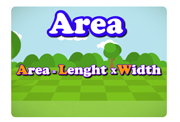 |
AREA The area of a plane figure (such a rectangle) is the number of square units needed to cover the surface of the figure when you find the area of the plane figure write down what units you are using (square feet, square meters, square units, etc.) |
|||||||||||||||||||||||||||||||||||||||||||||||||
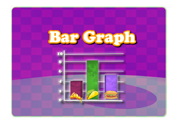 |
BAR GRAPH |
|||||||||||||||||||||||||||||||||||||||||||||||||
 |
CALENDAR Calendar measure time in days, weeks, months, and years. In 1 day, there are 24 hours. In 1 week, there are 7 days. |
|||||||||||||||||||||||||||||||||||||||||||||||||
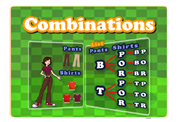 |
COMBINATIONS A combination is the way that different objects can be put together, the order does not matter.For example, abc is the same combination of letters as bca. Sometimes, you will need to figure out the probability that certain combination will happen. You need to figure out successful and total outcomes. |
|||||||||||||||||||||||||||||||||||||||||||||||||
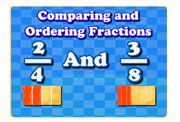 |
COMPARING AND ORDERING FRACTIONS When the fractions have the same denominator the large numerator, and the larger number when fractions have the same numerator the smaller the denominator, the larger the number, and remember always make a model to compare 2 fractions. |
|||||||||||||||||||||||||||||||||||||||||||||||||
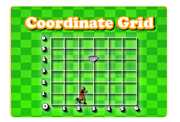 |
THE COORDINATE GRID The coordinate grid, the coordinate grid is made out of a horizontal axis which is also known as the x axis and the vertical axis that’s also known as the y axis, remember horizontal is like the horizon and vertical is up and down like vertical lines, in a coordinate grid we have ordered pairs, ordered pairs are points on a coordinate grid, an ordered pair is made up of two numbers inside of a parenthesis separated by a comma. |
|||||||||||||||||||||||||||||||||||||||||||||||||
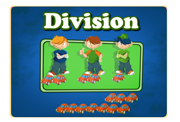 |
DIVISION When you divide a number or set of things you break it into equal groups. This is a division symbol, in division each number has a name there are 2 different ways of writing a division problem you can either write the problem out with the division sign for example: 15 /3=5 or you can write it this way in a little house. The number that you are braking into equal groups is called the dividend, the number that is being divided is the divisor. |
|||||||||||||||||||||||||||||||||||||||||||||||||
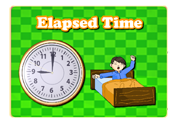 |
ELAPSED TIME Elapsed time is the time that has passed between 2 events, from the time you get out of school to the time you go to practice, from the time you wake up to the time you have lunch time has passed. |
|||||||||||||||||||||||||||||||||||||||||||||||||
 |
EQUATIONS Equations, when 2 expressions are equal to each other they make an equation just like any other equations or expressions or inequality, we need to find the missing number. |
|||||||||||||||||||||||||||||||||||||||||||||||||
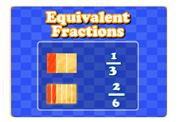 |
EQUIVALENT FRACTIONS Quick Tip for Equivalent Fractions. Remember to find equivalent fractions, which are fractions that represent the same amount, you may draw a model, use multiplication, or use division. And remember if you multiply or divide, whatever you do to the numerator you must do to the denominator. |
|||||||||||||||||||||||||||||||||||||||||||||||||
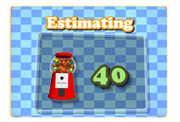 |
ESTIMATING You can use estimation when you add, subtract, multiply, or divide numbers, this will help you check your math make sure your answer make sense. You can also estimate when an exact answer is not necessary. |
|||||||||||||||||||||||||||||||||||||||||||||||||
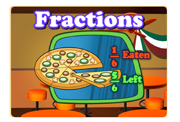 |
FRACTIONS A fraction represents a part of a whole or a part of a group.The numerator of the fraction tells how many parts of the whole or group you have. The numerator is the top number of the fraction. The denominator tells you how many parts the whole or group is divided into. The denominator is the bottom number of the fraction. |
|||||||||||||||||||||||||||||||||||||||||||||||||
 |
GEOMETRY (2 DIMENSIONAL FIGURES) Flat shapes such as circle, triangles, squares, and rectangles are 2 dimentional figures. They lie on a flat surface called aplane and can also be called plane figures.
|
|||||||||||||||||||||||||||||||||||||||||||||||||
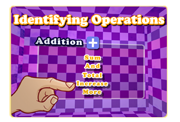 |
IDENTIFYING OPERATIONS When you came across word problems you have to find out whether you are going to add, subtract, multiply or divide and there are certain key words that help you identify whether you are going to use addition, subtraction, multiplication or division to solve your problem. |
|||||||||||||||||||||||||||||||||||||||||||||||||
 |
LENGTH You can measure or estimate length (or distance) using U.S. customary or metric units. Inches,feet, and yards are some of the U.S. customary units, used to measure length. Centimeters, meters, and kilometers, are some of the metric units used to measure length. |
|||||||||||||||||||||||||||||||||||||||||||||||||
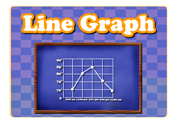 |
LINE GRAPH Line graph, line graph are used to show change in data over time. Line graph also have titles just like bar graph, we have the main title that tells us what the graph is about. We have a title on the x-axis and on our y-axis. |
|||||||||||||||||||||||||||||||||||||||||||||||||
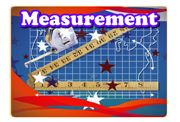 |
MEASUREMENT In the U.S we observe 2 different types of measure. The Metric unit and the customary unit of measure, but every other country in the world observe the Metric unit of measure. In length, the metric unit of measure is centimeter. And in Customary unit of measure talk is the inch or half inch. |
|||||||||||||||||||||||||||||||||||||||||||||||||
 |
MONEY Knowing how to count money is important in life. |
|||||||||||||||||||||||||||||||||||||||||||||||||
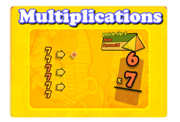 |
MULTIPLICATION When you multiply, the numbers being multiplied are called factors, and the answer is called the product. Sometimes when you multiply, you need to regroup and add to the next place value. |
|||||||||||||||||||||||||||||||||||||||||||||||||
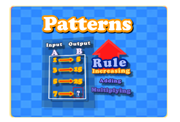 |
PATTERNS Patterns, in patterns we have geometric patterns and number patterns, Geometric patterns are patterns with shapes instead of numbers, lets take a look at different geometric patterns. When looking at a geometric pattern the most important to do is to find the rule and the order of the shape so that you are able to find out what comes next and there are different ways of finding out these rules. |
|||||||||||||||||||||||||||||||||||||||||||||||||
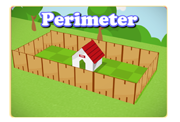 |
PERIMETER Perimeter equals distance around a figure. Just remember what Perimeter means, means around a figure. They may use words such as: fence, borders, edge, side. Just make sure you understand what Perimeter means. |
|||||||||||||||||||||||||||||||||||||||||||||||||
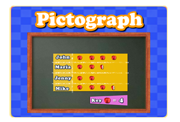 |
PICTOGRAPH A pictograph uses pictures to show data. Use the key to help you figure out the number of times that each value or result from the pictograph occurs. |
|||||||||||||||||||||||||||||||||||||||||||||||||
 |
PLACE VALUE Place value helps you understand the value of each digit in a number. When you look at place value, the value assigned to each place is 10 times the value assigned to the place to its right. |
|||||||||||||||||||||||||||||||||||||||||||||||||
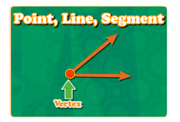 |
POINTS, LINES, SEGMENTS, RAYS, AND ANGLES A point is a single location in space. |
|||||||||||||||||||||||||||||||||||||||||||||||||
 |
PROBABILITY Probability is the chance that an event will or will not happen. |
|||||||||||||||||||||||||||||||||||||||||||||||||
 |
ROTATION AND TRANSLATION Any figure can be moved by transformation, they can slide, flip, or turn. And in Mathematics we have proper words that we use and vocabulary that represents a slide, a flip, or a turn. When you slide a figure in one direction, the movement is a translation. When you flip a figure over a line, the movement is a reflection. When you turn a figure around a point, the movement is a rotation. |
|||||||||||||||||||||||||||||||||||||||||||||||||
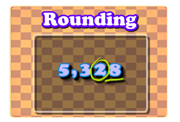 |
ROUNDING Rounding whole numbers, when rounding numbers there are steps to follow, here are the steps; first you need to circle the place value that is rounded, circle the place value that their asking you to round to, next you need to underline the digit to the right of the circled number. Then if the underlined digit is less than 5, then the circled digit stays the same or if the underlined digit is greater or equal to 5, then the circled digit increases by 1. Once you determined between the 2 of those you write a zero or zeros as placeholders for all the digits to the right of the circled digit. |
|||||||||||||||||||||||||||||||||||||||||||||||||
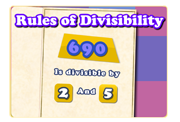 |
RULES OF DIVISIBILITY The rules of the divisibility are important because on the test they might ask you question like: what are the factors of 24? Factors are numbers that make up another number. What are the multiples of the number 2? Multiple is the answer in a multiplication problem. For that reason you need to know the rules of divisibility for the number 2 – 5 – and 10 |
|||||||||||||||||||||||||||||||||||||||||||||||||
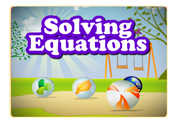 |
SOLVING EQUATIONS When you are given a word problem to solve, sometimes you need to write an equation that represents the information from the problem. The symbol will represent the value of the missing number. |
|||||||||||||||||||||||||||||||||||||||||||||||||
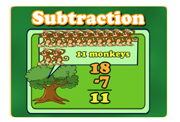 |
SUBTRACTION When you subtract, the number being subtracted from is called the minuend. The number being subtracted is called the subtrahend. The answer is called the difference. Sometimes when you subtract, you need to borrow and regroup. |
|||||||||||||||||||||||||||||||||||||||||||||||||
 |
SYMMETRY A figure has symmetry when it can be folded in half and both sides are equal. Some figures have no line of symmetry. |
|||||||||||||||||||||||||||||||||||||||||||||||||
 |
TEMPERATURE Temperature. Temperature can be measured in two different ways. We can use the US customary unit, which is degrees Fahrenheit, and it is represented by the degrees symbol and the capital F for Fahrenheit, or it could also be measured in the metric units of temperature, which are degrees Celsius. A thermometer is the instrument that we use to measure temperature. As you can see on one side of the thermometer we have degrees Celsius and on the other side of the thermometer we have degrees Fahrenheit. |
|||||||||||||||||||||||||||||||||||||||||||||||||
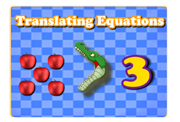 |
TRANSLATING EQUATIONS Just like we have equations that are 2 expressions joint together by an equal or a non equal sign. We have inequalities. An inequality are two expressions that are joined by a greater than or less than sign. |
|||||||||||||||||||||||||||||||||||||||||||||||||
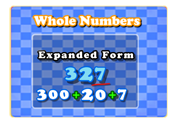 |
WHOLE NUMBERS Numbers are used to describe “how many” of something there are. Some of the numbers (0, 1, 2, 3, and so on) are known as whole numbers. Whole numbers are the numbers you use for counting. There are different ways of showing whole numbers. You can use digits, words, or models. |
|||||||||||||||||||||||||||||||||||||||||||||||||
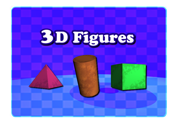 |
3 DIMENTIONAL FIGURES Three dimentional figures are not flat, three dimentional figures are space figures. Some 3 dimentional figures have faces, vertices edges and curves. |
|||||||||||||||||||||||||||||||||||||||||||||||||
|
||||||||||||||||||||||||||||||||||||||||||||||||||
|
||||||||||||||||||||||||||||||||||||||||||||||||||








